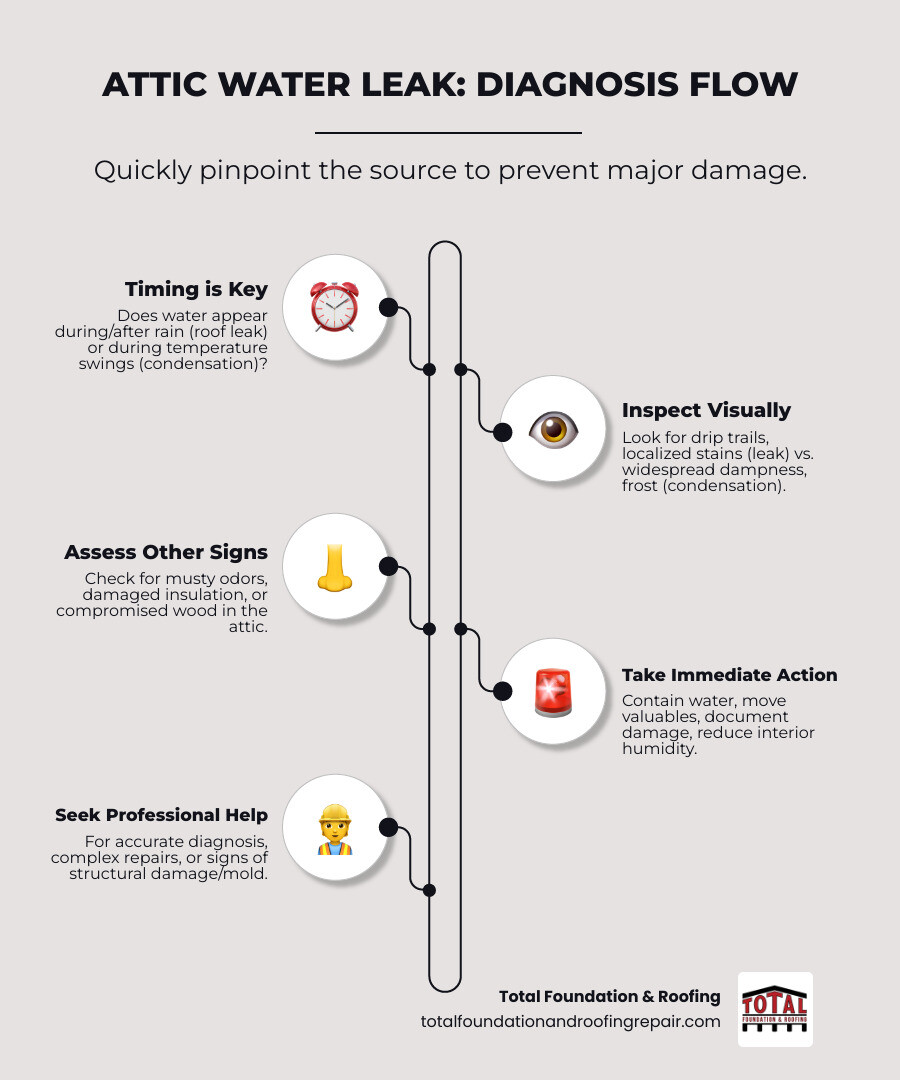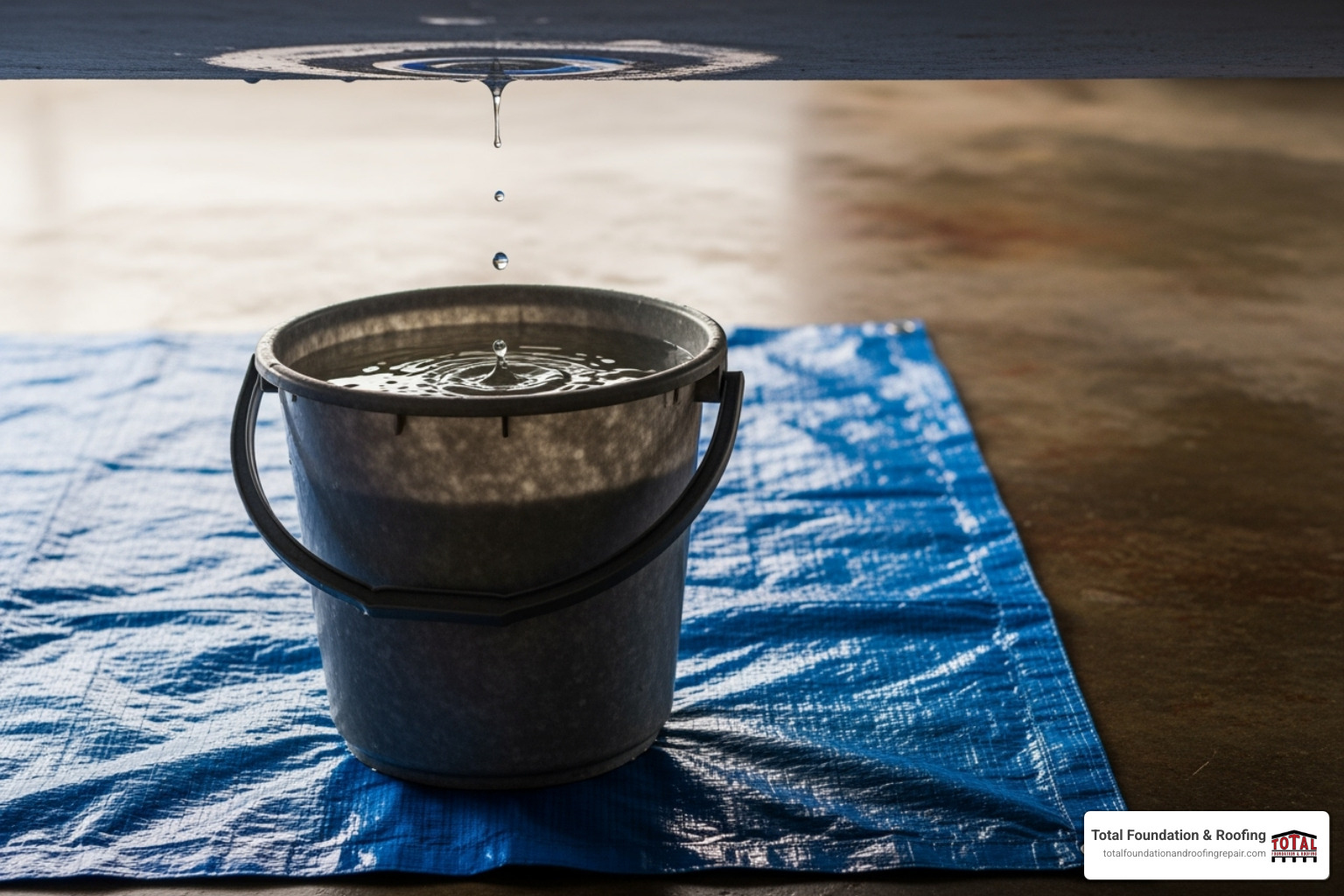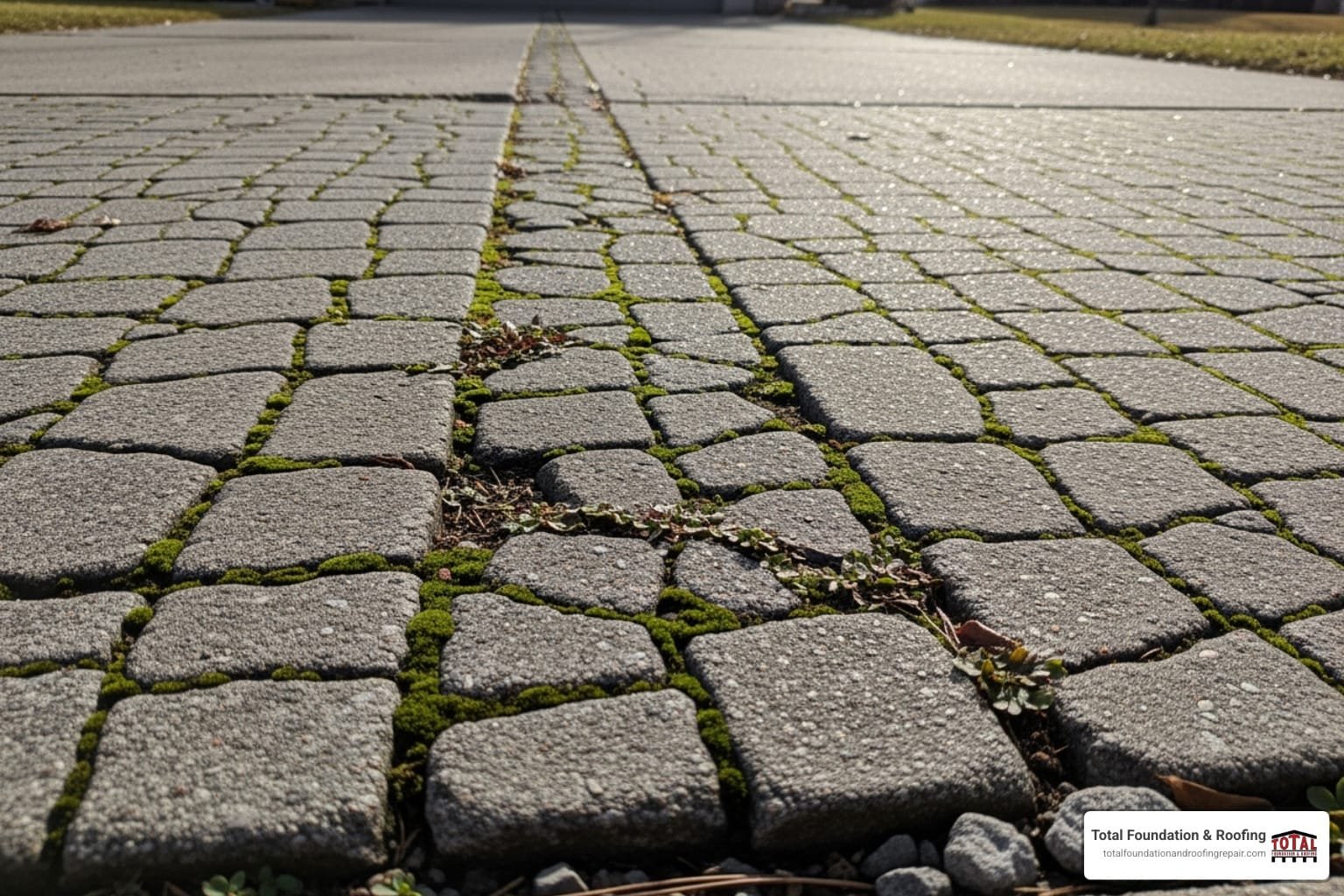Table of Contents
ToggleWhat’s That Drip in Your Attic?
Attic water leak problems can turn a peaceful home into a source of constant worry. Whether you’re hearing mysterious drips or noticing water stains on your ceiling, understanding the cause is crucial. Water damage escalates quickly, and what starts as a small drip can lead to structural damage and mold. For homeowners in the Texas Hill Country, our climate of intense heat and sudden storms creates perfect conditions for these issues. At Total Foundation & Roofing Repair, we know that prompt action is key to protecting your home.
Quick Diagnosis Guide for Attic Water Issues:
- Roof Leak Signs: Water stains appear during or after rain, drip trails visible, damage near roof penetrations
- Condensation Signs: Widespread dampness, frost buildup, occurs during temperature swings, musty odors
- Immediate Actions: Stop the water source, contain leaks, document damage, call professionals
- When to Worry: Visible mold, structural damage, electrical hazards, or recurring problems
The key is acting fast and knowing the difference between a true roof leak and attic condensation. Each requires a different solution, and a misdiagnosis can waste time and money while the damage spreads.
I’m Daniel Sowell, owner of Total Foundation & Roofing Repair, and over 18 years I’ve helped countless Texas homeowners solve attic water leak mysteries. From storm damage to tricky condensation, I’ve seen how quick, proper diagnosis can save homes and wallets.

Diagnosing Your Attic Water Leak: Leak or Condensation?
Time to put on your detective hat! Successfully solving an attic water leak starts with figuring out if water is sneaking in from outside or building up from inside. Getting this right is crucial because the fixes are completely different.
Key Signs of Water Damage in the Attic
Water damage leaves a trail of clues. Your first red flags are often water stains and discoloration—yellowish or brown marks on ceilings, insulation, or wood. A persistent musty smell is your nose telling you there’s a moisture problem, often before you see it. Look for damp or compressed insulation, which loses its ability to keep your home comfortable and becomes a breeding ground for mold. If the leak has reached the ceiling below, you might see paint bubbling or peeling. Finally, visible mold or mildew as black, green, or white patches means the problem has been going on for a while. Regular inspections can help you spot these Signs of Hidden Water Damage before they become disasters.

Pinpointing the Cause: A True Roof Leak
A roof leak means water is getting in from outside, usually during or right after rain. In the Texas Hill Country, this is common after our notorious hailstorms. The main culprits are often damaged or missing shingles and cracked or damaged flashing around chimneys, vents, and skylights. Clogged gutters can also cause water to back up and seep into your attic. Sometimes, wind-driven rain forces water under shingles even on an intact roof. Another common issue is damaged roof penetrations; anything that causes a penetration in the roof, like vents or satellite dishes, is a potential weak spot. Finally, tree limb damage from scraping or falling branches can create an entry point for water. Pinpointing the exact source can be tricky, which is why we sometimes use tools like Thermal Imaging to Detect Roof Leaks.
The Hidden Culprit: Attic Condensation
Attic condensation is often mistaken for a roof leak. It happens when warm, moist air from your living space rises and hits cold surfaces in the attic, turning into water droplets. The biggest cause is poor ventilation, which traps humid air. Inadequate insulation allows warm air to escape into the attic too easily. High indoor humidity from showering and cooking, combined with improperly vented fans that dump moist air into the attic instead of outside, creates the perfect storm for condensation. If you find condensation on your windows, your home’s humidity might be too high.
| Feature | True Roof Leak | Attic Condensation |
|---|---|---|
| Cause | External water penetration (rain, snow, ice) | Internal humidity meeting cold surfaces |
| Appearance | Drip trails, localized stains, often near roof features | Widespread dampness, frost buildup, “attic rain” |
| Timing | During or immediately after rain/snow | During cold spells, especially after temperature changes |
Understanding these differences puts you on the right path toward fixing the real problem.
Your Action Plan: From Immediate Fixes to Long-Term Prevention
Once you’ve identified the likely cause of your attic water leak, it’s time to act. This involves immediate steps to mitigate damage and long-term strategies to prevent it from happening again.
Immediate Steps for an Attic Water Leak
Finding a leak is alarming, but quick action can minimize damage and cost.
- Safety First! If water is near electrical wiring, turn off power at the breaker before entering the attic.
- Contain the Water: Place a bucket under the drip to catch water. If the ceiling is bulging, you can carefully puncture it to relieve pressure and drain the water into the bucket, but be certain it’s not near wiring.
- Move Valuables: Relocate any items that could be damaged by water.
- Document the Damage: Take clear photos and videos of the leak and any damage for your insurance claim.
- Reduce Interior Humidity: If you suspect condensation, run exhaust fans and a dehumidifier to lower moisture levels in your home.
- Call for Professional Help: Once the situation is contained, call an expert. A professional can accurately diagnose the problem, perform repairs, and address any secondary damage like mold.

Long-Term Consequences of an Attic Water Leak
Ignoring an attic water leak can lead to devastating and costly consequences. Prompt restoration is critical to avoid:
- Structural Wood Rot: Prolonged moisture weakens wooden beams and rafters, which can lead to a sagging roof or even collapse.
- Widespread Mold Growth: A damp attic is a perfect breeding ground for mold, which can spread through your home and impact air quality and health.
- Compromised Insulation: Wet insulation becomes matted and ineffective, leading to higher energy bills.
- Electrical Hazards: Water near wiring can create fire risks, short circuits, or electrocution hazards.
- Damaged Ceilings and Walls: Water will eventually stain, warp, and damage the ceilings and walls below.
- Reduced Property Value: All of these issues significantly decrease your home’s value and deter potential buyers.

Prevention: Your Best Defense & When to Call a Pro
Proactive maintenance is the best way to prevent an attic water leak.
- Regular Roof Inspections: Have a professional inspect your roof annually and after severe storms to catch issues early.
- Keep Gutters Clean: Ensure gutters and downspouts are clear of debris to allow proper water drainage away from your roofline.
- Ensure Proper Attic Ventilation: A balanced system of intake and exhaust vents is crucial for removing moist air and preventing condensation.
- Check Insulation Levels: Adequate insulation keeps warm, moist air in your living space and out of the attic.
- Seal Air Leaks: Use caulk or foam to seal gaps around light fixtures, pipes, and attic hatches to stop humid air from rising into the attic.
- Vent Appliances Outdoors: Make sure all bathroom fans, kitchen hoods, and dryers vent directly outside, not into the attic.
- Trim Overhanging Trees: Keep branches away from your roof to prevent scraping or damage from falling limbs.
While some tasks are DIY-friendly, diagnosing and repairing roof and ventilation systems requires expertise, especially in areas like Kerrville with unique climate demands. For a definitive diagnosis and lasting repair, it’s always best to call a certified professional. The team at Total Foundation & Roofing has the experience to handle any attic water issue. For expert help, explore our Roof Leak Detection Services.





